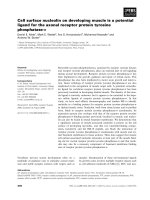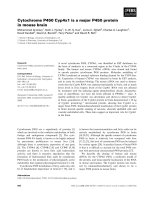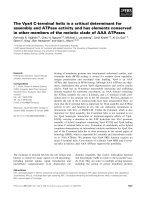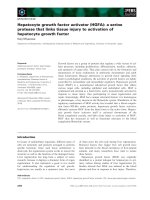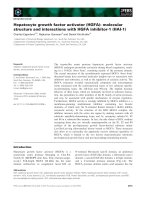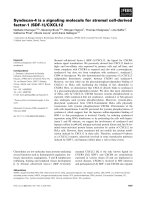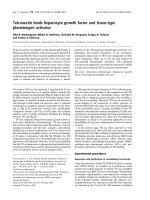HEPATOCYTE GROWTH FACTOR IS a MAJOR CYTOKINE FOR NSC HOMING TO GLIOMA
Bạn đang xem bản rút gọn của tài liệu. Xem và tải ngay bản đầy đủ của tài liệu tại đây (3.09 MB, 128 trang )
HEPATOCYTE GROWTH FACTOR
IS A MAJOR CHEMOTACTIC FACTOR FOR
NEURAL STEM CELLS MIGRATION TO GLIOMA
HUANG SIHUA
(B.ENG. (Hons), NTU)
A THESIS SUBMITTED
FOR THE DEGREE OF DOCTOR OF PHILOSOPHY
DPARTMENT OF PHYSIOLOGY
YONG LOO LIN SCHOOL OF MEDICINE
NATIONAL UNIVERSITY OF SINGAPORE
2015
I
Declaration
I hereby declare that the thesis is my original work and it has been
written by me in its entirety. I have duly acknowledged all the
sources of information that have been used in thesis.
This thesis also not been submitted for any degree in any university
previously.
________________________
Huang Sihua
16
th
Jan 2015
II
Acknowledgements
This dissertation would not have been possible without the opportunity
given by Singapore-MIT Alliance of Research and Technology (SMART), Yong
Loo Lin School of Medicine, and the constant support and encouragement from
the following people:
First and foremost, I would like to thank my supervisors Professor
Roger Kamm and Professor Hanry Yu. In spite of his busy schedule, Professor
Kamm always made time to talk to me about my problems in research. He
promptly and carefully replies all our email requests. He will not blame me
when the experiments are not working out. Instead he is always there to help
and guide me through my difficulties. I am truly thankful to Professor Kamm
for bringing me the courage and inspiration to pursue my studies.
Professor Hanry Yu is my local supervisor. He cares for students in a
professional and personal level. He would discuss with us about our projects
for hours until we have a satisfying answer. He patiently teaches us the skills
we needed in research and academia. He has even made time to teach me the
specific details on how to write a paper. Professor Yu has given me valuable
suggestions and creative ways to solve the problems. He has supported me in
so many different ways.
I would also like to thank my colleagues in BioSystems and Micromechanics
unit (BioSyM) under the Singapore-MIT Alliance of Research and Technology
(SMART), Yu Lab (Physiology, NUS), and Kamm Lab (Bioengineering, MIT). My
special thanks go to: Dr. Poon Zhiyong, Dr. Lim Sei Hien, Dr. Zhou Yan, Mr. Tu
III
Ting Yuan, Dr. Andrea Pavasi, Mr. Ng Inn Chuan, Dr. Jacky Lee, Dr. Tan Chin
Wen, Mr. Evan Tan, Ms. Michelle Chen, Mr. Kwok Chee Keong, and Ms. Averil
Chen, who have been there to assist me strategically, technically, and socially.
IV
Table of Contents
Declaration I
Acknowledgements II
Table of Contents IV
Summary VII
List of Tables IX
List of Figures X
CHAPTER 1 1
INTRODUCTION 1
1.1 Brief background on neural stem cells 1
1.1.1 Origin 1
1.1.2 Sources of Neural stem cells 2
1.1.3 Therapeutic use of neural stem cells 6
1.2 Glioma 7
1.2.1 Types of Glioma 7
1.2.2 Therapies to treat glioma: traditional and new 8
1.3 Glioma tropism of neural stem cells 12
CHAPTER 2 16
LITERATURE REVIEW 16
2.1 Cytokines involved in NSC tumor homing 16
2.2 SDF1α/CXCR4 18
2.3 VEGF 20
2.4 uPA 21
2.5 IL-6 21
2.6 SCF/c-kit 23
2.7 HMGB1 24
2.8 EGF 25
2.9 HGF/c-Met 25
2.10 MCP1/CCR2 27
2.11 Glioma-produced ECM 27
2.12 Summary and Outlook 28
CHAPTER 3 30
OBJECTIVES 30
3.1 Specific Aim One: Develop in vitro Assays to Study NSC Homing to
Glioma 31
3.2 Specific Aim Two: Identify the major homing signals using in vitro
experiments in terms of gene and protein expression levels in glioma cells
versus astrocytes 32
3.3 Specific Aim 3: Validation of the identified major NSC homing signal(s)
in vitro and in vivo 33
CHAPTER 4 34
NEURAL STEM CELLS DISPLAY TROPISM TOWARDS GLIOMA IN
TRADITIONAL TRANSWELL ASSAYS AND MICROFLUIDIC DEVICES 34
4.1 Introduction 34
4.2 Materials and Methods 35
V
4.2.1 Cell culture 35
4.2.2 Conditioned medium 37
4.2.3 Transwell Assay 37
4.2.4 Microfluidic devices 38
4.2.5 Seeding NSCs into microfluidic devices 39
4.2.6 Statistical Analysis 40
4.3 Results and Discussion 40
4.3.1 U87 glioma conditioned media induces NSC migration. 40
4.4 Conclusions 48
CHAPTER 5 50
HGF, VEGF, AND IL6 ARE CANDIDATE CYTOKINES THAT REGULATE NSC
HOMING TO GLIOMA; 50
HGF IS THE MOST PROMISING SIGNAL. 50
5.1 Introduction 50
5.2 Materials & Methods 52
5.2.1 Cell culture 52
5.2.2 Conditioned media 52
5.2.3 Transwell Assay 52
5.2.4 Reverse transcription-PCR 53
5.2.5 ELISA (Sandwich Enzyme-Linked Immunosorbent Assay) 55
5.2.6 Flow Cytometry 55
5.2.7 Statistical Analysis 56
5.3 Results & Discussion 56
5.3.1 HGF, VEGF, and IL6 were upregulated in U87 glioma cells comparing to
normal astrocytes. 56
5.3.2 HGF has higher chemotactic potency than VEGF and IL6. 59
5.3.3 NSCs express receptors for HGF, VEGF, and IL-6 64
5.3.4 Among three candidate signals, HGF induced maximum migration of NSCs in
transwell assay. 66
5.4 Conclusions 73
CHAPTER 6 75
BLOCKING HGF RECEPTOR INHIBITS NSC TROPISM TO GLIOMA; NSCs ARE
CHEMOTACTIC TO HGF IN LIVE CONDITION 75
6.1 Introduction 75
6.2 Materials & Methods 76
6.2.1 Transwell Assay – Blocking 76
6.2.2 Dunn’s chamber 77
6.3 Results & Discussion 78
6.3.1 Blockades of CMET (HGF receptor) and VEGFR2 (VEGF receptor) were able to
reduce NSC migration. Blocking of CMET imposed greater inhibition on NSC
migration than blocking of VEGFR2. 78
6.3.2 NSCs are chemotactic to HGF gradient in Dunn Chamber 84
6.4 Conclusions 89
Chapter 7 91
Additional Results & Future Experiments 91
7.1 Summary 91
7.2 Methodology 94
7.2.1 Endothelial monolayer 94
7.2.2 Vascular network & NSC infusion 94
7.2.3 Transfecting U87 cells with RFP 96
VI
7.2.4 In-vivo protocol 97
7.3 Additional Results, Discussion & Future Plan 98
7.3.1 Forming endothelial monolayer in microfluidic devices 98
7.3.2 Forming vascular network within the 3-D gel region of microfluidic devices
101
7.3.3 Observing NSC extravasation from the vascular network and homing to
glioma 103
7.3.4 Observing NSC homing to glioma in vivo 106
7.4 Future explorations 108
References 109
VII
Summary
Neural stem cell (NSC) homing to brain tumor has been exploited for targeted
gene therapy, but the underlying mechanism remains unclear. Various signals
were proposed by the literature. We hypothesize that among the 9 known
signals we chose from the literature, there would be a major homing signal
regulating NSC homing to glioma.
Our first specific aim is to observe the homing of NSCs towards glioma in vivo
and in vitro. Transwell and microfluidic assays are used and homing was
confirmed in both assays.
Our second specific aim is to determine the major cytokine(s) that regulates
NSC glioma tropism among the 9 known cytokines. We screened these 9 factors
for up-regulated gene expression in U87 glioma cells relative to non-cancerous
astrocytes. Only VEGF, IL6, and HGF were up-regulated in U87 glioma cells,
among which HGF showed the highest up-regulation of >400 fold over
astrocytes, versus 2 fold for VEGF and 10 fold for IL6. Similar trends were
observed in protein expression measured by ELISA. In transwell assays, HGF
induced significant NSC migration relative to VEGF and IL6. Through FACS
experiment we also found that NSCs have the highest expression of HGF
receptor over the receptors for VEGF and IL6.
VIII
Our third specific aim is to further explore the role HGF plays in NSC homing to
glioma. We found that blocking HGF receptor inhibited NSC migration towards
glioma conditioned medium. In live imaging, NSCs migrated along HGF gradient.
We conclude that HGF is a major chemoattractant in NSC homing to glioma.
IX
List of Tables
Table 1. List of pre-clinical trials that make use of NSCs as cellular carriers
to deliver therapeutic transgene into tumor bearing mice 13
Table 2. List of important signaling pathways involved in NSC homing to
glioma 18
Table 3. Primer sequences of various cytokines used for RT-PCR
experiments 54
Table 4. Amount of HGF, VEGF, SDF-1, and IL-6 secreted by astrocytes and
U87 glioma cells 62
Table 5. List of dissociation constants of HGF, VEGF, and IL6 63
Table 6. Molecular Weight of HGF, VEGF, and IL6 68
Table 7. Parameter of migration in control condition and HGF gradient 87
X
List of Figures
Figure 1. Stem cell mediated CNS regeneration and therapeutic delivery
[15]. Stem cells, neural stem cells especially, have been used in cell
replacement, remyelination, promotion of host tissue regeneration,
enzyme replacement therapy for neuroprotection, and tumor-localized
chemotherapy production. 6
Figure 2. Cell based anti-cancer therapeutics. Transplanted neural stem
cells (NSCs) homing to tumor cells in rodent models of brain neoplasia
[34]. 13
Figure 3. Conditioned media derived from U87 glioma cells induced
significant migration of NSCs in a transwell assay. Columns, cell
number per field; bars, SE; Statistical comparison were calculated
between cells induced by conditioned medium and control using
Student’s t test. Fluorescent images of migrated NSCs were shown in
control, conditioned media, and 2% FBS. 41
Figure 4. Growth of NSCs in different mixtures of gels. Phase contrast
images were taken for cells cultured in 48-well plate. 1 M/ml of NSCs
were used. Images were taken 4 h after gelation. The concentration for
each gel used is 2mg/ml. 42
Figure 5. A) Top view of microfluidic device. NSCs are seeded in the channel
depicted in green and glioma cells are seeded in the other channel
shown in red. B) Dimensions of microfluidic device [77] 44
Figure 6. Figure A&B are magnification of central part of the microfluidic
device. Neural stem cells (shown in green) are seeded in the lower
channel. In Figure A, no cells are placed in the upper channel while in
Figure B, U87 glioma cells are seeded together with neural stem cells.
Images were taken one week after cell seeding. A) NSCs migrate to a
minimal distance into the central gel region without any inducement.
B) NSCs migrate much further into the central gel region and more
NSCs migrate in response to U87 glioma cells relative to control. C)
Measurement of migration distance under control condition and
condition with U87 cells. With inducement by U87 cells, the migration
distance is significantly greater. Migration distance is the distance from
the center of mass (COM) of the cell to the gel-channel interface. 47
Figure 7. HGF, VEGF, and IL6 were upregualted in U87 glioma cells
comparedµµ to normal astrocytes. mRNA were collected from glioma
cells and astrocytes and the amount of mRNA were determined using
real time-PCR. Columns, fold increase. Bars, standard deviation. ****,
P<0.0001 57
XI
Figure 8. Glioma cells secreted more HGF, VEGF, and IL6, and less SDF1 than
astrocytes. Conditioned media were collected from the cells and
concentrated by ultra-centrifugal units. ELISA was performed to
quantify the amount of cytokines secreted by the cells. All data were
obtained in triplicate and are represented as mean+ SD. ****, p<0.0001
61
Figure 9. HGF has a higher chemotactic potency comparing to VEGF and IL6.
Conditioned media were collected from the cells and concentrated by
ultra-centrifugal units. ELISA was performed to quantify the amount of
cytokines secreted by the cells. All data were obtained in triplicate and
are represented as mean+ SD. ****, p<0.0001. 63
Figure 10. Expression of cMET, VEGFR2 and IL6R by NSCs. The fluorescence
signals detected from cells positively stained by the receptor
antibodies are shown. c-MET is more highly expressed than VEGFR2
and IL6R. *P<0.05; **P<0.01; bars, SD 65
Figure 11. HGF was able to induce the most significant migration of NSCs.
Transwell assay was used to study the effects of chemoattractants
VEGF, IL6, and HGF on NSC migration. Chemoattractants were added at
the bottom well and NSC were seeded at the top well. Columns, cell
count per field. Bars, standard deviation. ****, P<0.0001 67
Figure 12. Dextran gradient established across the gel region of microfluidic
devices. Dextran with red fluorescence was introduced into one
channel, and media was placed into the other channel. Two channels
are separated by collagen-Matrigel mixture. Fluorescence was
recorded over 6 h and analyzed. Horizontal axis: Distance from the
analyzed point to the gel-media interface. Vertical axis: normalized
fluorescence for each point. 6 different colors of curves represent
different point of time. 69
Figure 13. NSCs are attracted to HGF gradient in microfluidic devices. NSCs
were seeded at the lower channel, media or HGF was added to the
upper channel. Cells were allowed to migrate for 11 days and images
were taken at day 6, day 9, and day 11. 71
Figure 14. Blocking VEGFR2 using 1uM Vatalanib reduces the migration, but
not as much as 100nM JNJ. Combination of 1uM Vatalanib and 100nM
JNJ is not significantly different from 100nM JNJ alone in blocking NSC
migration. Increasing the concentration of both chemicals further
reduces NSC migration. Vatalanib is a VEGFR2 blockade with IC50 of
~40nM. JNJ is a c-MET blockade with IC50 of ~4nM. ****, p<0.0001;
***, p<0.001; ns, not significant 79
Figure 15. Blocking VEGF and CMET receptor alone is able to reduce NSC
migration. But blocking CMET receptor has a significantly greater
inhibition on NSC migration. ****, p<0.0001; ***, p<0.001; **, p<0.01. 81
XII
Figure 16. Blocking HGF receptor c-MET using chemical JNJ is able to induce
a dose-dependent inhibition on NSC migration. Transwell migration
assay was used. NSCs were incubated with chemical blockades before
added to transwell. Vatalanib, an inhibitor of VEGFR2with IC50 of 37
nM. JNJ (JNJ-38877605), an inhibitor of c-Met with IC50 of 4 nM. ****,
p<0.0001; ***, p<0.001; ns, not significant. 83
Figure 17. NSCs are chemotactic to HGF gradient. Migration tracks of NSCs
under no gradient (A) and HGF gradient (C). Black tracks – overall
positive migration. Red – overall negative migration. Directionality
histogram of NSC migration under no gradient (B) and HGF gradient
(D). Dunn chamber was used and time lapse images were captured
every 5 minutes for 6 h. Cells were tracked using Metamorph software
and analyzed by Ibidi Chemotaxis and Migration Tool. 85
Figure 18. Forward Migration Index (FMI) of NSCs under control condition
and HGF gradient. 86
Figure 19. pRetroQ-mCherry-N1 Vector Map and Multiple Cloning Sites
(MCS) 96
Figure 20. Forming endothelial monolayer in the channel of microfluidic
devices. 2.5M/ml of endothelial cells were seeded in Matrigel coated
microfludic channel. 3 days after seeding, cells were fixed and stained
with DAPI. A) Top view of the monolayer. B) Side view of the
monolayer. C) Picture of device. D) Schematic view of high-throughput
microfluidic device 99
Figure 21. A) Schematic diagram of 3-gel device (top view). B) Schematic
diagram of 3-gel device (side view). C) Picture of 3-gel microfluidic
device. D) Endothelial cells form vascular network in the gel region of
microfluidic devices. E) Endothelial cells form vascular network under
the presence of U87 glioma cells. F) 3-D image of glioma vasculature.
G) Projected image of glioma vasculature. Green: VE-cadherin; Red:
U87-RFP cells; Blue: DAPI; White: Phalloidin 101
Figure 22. Process of NSC extravasation from endothelial network and
homing towards U87 cells. Image A, B, C, D represent images taken at
0.5 hr, 1.5hr, 2.5hr, and 3.5hr after introducing NSCs into the glioma
vasculature. Red: endothelial cells with RFP; Green: NSC GFP 103
Figure 23. A) 3-D image showing NSCs escaping from the vascular network
and homing to glioma cells. B) Projection image showing NSCs escaping
from vascular network and homing to glioma cells. Red: U87 RFP cells;
Green: NSC GFP cells; Blue: DAPI; White: Phalloidin 104
XIII
Figure 24. A) The set-up of in vivo experiment using stereotaxic instrument.
B) Isolated mouse brain with established glioma shown in red. C)
Migration of NSCs (Red) from the original cell mass towards the
established glioma (unseen) at the right frontal lobe. 106
1
CHAPTER 1
INTRODUCTION
1.1 Brief background on neural stem cells
Neural stem cells (NSCs) are referring to cells that can self-renew and
differentiate into all three lineages of neuronal cells: neurons, astrocytes, and
oligodendrocytes.
1.1.1 Origin
Neural stem cells can be isolated from central nervous system of embryonic,
fetal, and adult individuals. These cells originate from the neuroectoderm of
the early embryo. The embryonic NSCs are the neuroepithelial cells (NEP).
They are rapidly multiplying cells that form the neural plate and then neural
tube, which later develop into the mature CNS [1]. The molecular markers of
this cell type include SOX1, an early NSC maker; as well as intermediate
filament nestin [2]; and CD133, a cell surface associated transmembrane
protein [3]. Oct4, a transcription factor responsible for pluripotency, is also
expressed by early NEPs [4].
Towards the end of embryonic development, asymmetric division occurs and
the neuroblast appears. Meanwhile, the neuroepithelium converts into a
2
tissue consisting of different cell layers. The most apical layer includes radial
glial cells (RGCs), a secondary NSC that is different from NEPs as primary
NSCs [5]. Another type of secondary neural stem cell is basal stem cell. This
cell type is generated by asymmetric division of neuroepithelial cells and after
depletion of this cell pool, also by asymmetric division of RGCs. Basal stem
cells are located at the subventricular zone (SVZ) and they are neural stem
cells of restricted lineages, developing into neurons after one or two
symmetrical divisions [6].
Additional stem/progenitor cells exist to generate neurons, astrocytes, and
oligiodendrocytes, not only during development, but also in adult CNS. In the
adult brain, neurogenesis mainly occurs in two regions: the SVZ of the basal
forebrain along the lateral ventricle, and the subgranular zone (SGZ) of the
hippocampal dentate gyrus. Other areas of the brain as well as the spinal cord
have also been reported to contain proliferating neurogenic cells.
1.1.2 Sources of Neural stem cells
Embryonic stem-derived NSCs
Embryonic stem cells (ESCs) have the pluripotency to generate all types of
cells. Several protocols have been proposed to derive neural progeny from
ESCs. In summary, three methods are reported to generate NSCs from ESCs.
The first method is through the generation of embryoid bodies [7]; the second
method leads to generating neural rosettes under adhesion conditions and
3
transiently supplementing Noggin to the culture medium [8]; the third
method involves differentiation of EBs into neural cells with sequential
addition of retinoic acid, Sonic hedgehog (Shh), and cAMP [9]. The protocols
have been used to generate a variety of neural cell types including astrocytes,
oligodendrocytes, glutamatergic, GABAergic, and dopaminergic neurons.
However, the characterization and single-cell clonogenic potential still needs
further clarification [10].
Fetal and adult NSCs
Adult NSCs divide slowly and therefore it is not feasible to establish a human
NSC cell line from isolated adult NSCs. However, NSCs can be successfully
isolated from the telencephalic di-encephalic region or from the subgranular
region of the fetal human brain [10].
Several clonal, genetically homogeneous human NSC cell lines have been
established by genetic modification. These cell lines are usually immortalized
with V-MYC or C-MYC genes. They have the advantages of their non-
transformed nature, human origin, mulitpotency, fast growth, high
availability, and feasibility for molecular manipulation. These cells hold great
potential for the development of cell replacement or gene transfer-based
therapies. It is also shown by a recent study that V-MYC modified neural
progenitors derived from fetal human brain have no tumorigenic potential
4
either in vitro or in vivo[11]. In our study, we will also be using a fetal NSC
cell line immortalized with V-MYC.
Induced pluripotent stem cells
A major obstacle of utilizing NSCs in clinical applications is the need for fetal
brain tissue. There is limited availability of fetal tissue and it raises multiple
moral and ethical complications. Therefore having a renewable source of NSCs
would greatly benefit potential therapeutic approaches. Recently, induced
Pluripotent Stem Cells (iPSCs) have been proposed as an alternative source of
neural cells because they share similar properties as embryonic stem cells and
the potential to differentiate into any somatic cell type. And they may provide
the benefits of minimal immune rejection.
iPSCs have multiple advantages: first the ability to generate stem cells from
skin fibroblasts without the need for human embryos to generate ESCs;
secondly, they are able to generate neurons, astrocytes and oligodendrocytes
from adult patients; thirdly, they provide the opportunity to investigate how
different cell types may be involved in a specific pathology; last but not least,
they can be used to characterize the bio-molecular mechanisms that underlie
the development of a chronic disorder[12].
5
However, the genetic manipulation of iPSCs may lead to tumor formation,
which needs to be addressed before they are used as cell transplant into
patients.
CNS cancer stem cells
By applying the same culture system developed for neural stem cells, long-
term stable cell lines can also be derived from human glioblastomas. These
cells can also be differentiated into the major three lineages neuronal cells:
neurons, astrocytes, and oligodendrocytes [13]. These cells, when they are
injected subcutaneously and intracranially, form primary glioblastoma and
have extensive migratory capacity, therefore these cells offer enormous
potential to establish pathological models [14].
6
1.1.3 Therapeutic use of neural stem cells
Figure 1. Stem cell mediated CNS regeneration and therapeutic delivery [15].
Stem cells, neural stem cells especially, have been used in cell replacement,
remyelination, promotion of host tissue regeneration, enzyme replacement
therapy for neuroprotection, and tumor-localized chemotherapy production.
Neural stem cells are used in multiple areas (Figure 1). They are used in cell
replacement therapies to treat neurodegenerative diseases such as
Alzheimer’s disease. They aid in re-myelination processes when there is
spinal cord injury or Pelizaeus-Merzbacher Disease. Neural stem cells also
promote host tissue regeneration by secreting neurotrophic factors. In
enzyme replacement therapy, NSCs are employed as a cellular carrier for
lysosomal enzymes that can be released and protect host neurons. In tumor-
localized chemotherapy against brain tumor, NSCs are genetically engineered
to carry enzymes, which can transform systematically or orally administered
7
prodrug into an active form at the tumor foci and kill the tumor cells. In this
study, we focus on tumor-localized chemotherapy and we aim to
improve the therapy through studying of the mechanisms of homing to
brain cancers.
1.2 Glioma
Glioma is the most common primary intracranial tumor. 7 out of 100,000
individuals are diagnosed with glioma every year. Despite tremendous efforts
to understand the development of the disease, this is still no cure. And the
median survival rate for patients with glioma is 12-15 months [16, 17].
1.2.1 Types of Glioma
According to the World Health Organization (WHO), gliomas are graded from
1 to 4. Grade 1 glioma is benign and circumscribed with a slow proliferation
rate. It includes the most common glioma of children: pilocytic astrocytoma.
Grade 2 glioma includes astrocytoma, oligodendroglioma, and
oligoastrocytoma. They also have relatively slow growth rates but these
tumors start to diffuse to normal brain and have a higher potential of
malignant progression. Grade 3 tumor is characterized by a higher cellular
density and the existence of atypical and mitotic cells. Grade 4 tumors are the
most malignant and happen most frequently. They include glioblastoma and
8
gliosarcoma. They have properties of micro-vascular proliferation or pseudo-
palisading necrosis [17].
1.2.2 Therapies to treat glioma: traditional and new
The current standard of care for patients of glioma includes maximal safe
resection, followed by radiation therapy (RT) to the resection cavity and
chemotherapy (telozolomide or TMZ). Surgical resection alone will lead to
survival of about 6 months, and when combined with RT survival extends to
12.1 months. Adding telozolomide further extends survival to 14.6 months
[18, 19].
Surgery is still an important aspect of treatment. It helps to reduce
intracranial pressure, and sometimes leads to recovery of certain neurological
function. However the disadvantages are obvious too, due to poor
performance status, advanced age of the patients, and involvement of other
parts of the brain [20].
The combination of RT and TMZ is most efficacious after the primary
resection. Treatment after surgery usually includes 6 weeks of RT to the
surgical cavity and TMZ, and after that, 6 cycles of TMZ [19]. RT of
glioblastoma multiforme (GBM) is focal, fractionated external beam radiation
therapy to the surgical resection cavity and to a 2cm margin of surrounding
9
brain tissue [21]. Ionizing radiation induces single strand and double strand
DNA breaks in proliferating cells. TMZ is an oral alkylating chemotherapeutic
agent. It derives its therapeutic effect from adding a methyl group to purine
bases of DNA, causes DNA damage, and triggers a cascade of events, leading to
tumor cell apoptosis [22]. TMZ alone has very limited clinical benefits. It is
when applied concurrently with RT it prolongs the survival of glioma patients.
However, the progression-free survival time is still only 7 months despite all
these efforts[23].
Molecular targeted therapies
Molecular targeted therapies can be divided into small molecule inhibitors
and monoclonal antibodies. Small molecule inhibitors are non-polymeric,
organic compounds able to cross cell membrane and target specific
intracellular components. Many of the small molecule inhibitors are tyrosine
kinase inhibitors. They act by selectively targeting the intracellular kinase
domain of receptor tyrosine kinases (RTKs). In contrast, monoclonal
antibodies are usually too large to cross the cell membrane and they target
cell surface proteins and extracellular peptides [22, 24].
These molecular targeted therapies can inhibit growth factor pathways such
as EGFR pathway. Amplification of EGFR signaling is one the most common
genetic alteration seen in GBM [25]. Some of them inhibit angiogenic
10
pathways. Glioma is a highly vascularized tumor characterized by extensive
angiogenesis. VEGF is critical for angiogenesis and is highly expressed in
glioma. Several small molecule inhibitors are used to block this pathway and
inhibit angiogenesis in the tumor site. Some of the molecules block
intracellular signaling pathways such as PI3K/AKT/mTOR and
RAS/RAF/MAPK as secondary messenger systems inside the cells.
Immunotheray
Immunotherapy intends to make use of the immune system to selectively
target glioma cells. There are two types: passive immune therapy and active
immune therapy. Passive immune therapy uses antibodies, immune cells, or
other components of the immune system to target the tumor. It does not
require activation of patients’ own immune system. Immune cells are
activated outside the body and re-injected into the patients. Active immune
therapy requires activating the patients’ own immune system. It includes
peptide-based therapy and cell-based therapy. These are usually referred to
as cancer vaccines.
Gene therapy
Gene therapy for the treatment of cancer involves delivering genetic material,
including transgenes, toxins, and viruses, into tumor cells to induce cell death.
The genetic material is usually packed within a vector to deliver into the cells.
11
There are various kinds of vectors including viral and non-viral vectors. Viral
vectors include retro-viruses, adenoviruses, and herpes simplex viruses type
1 (HSV-1). Adenoviruses and HSV-1 are able to deliver materials into the
nucleus of the host cell but they are not able to integrate into the host cell
DNA [26].
In addition to viruses, stem cells have been used as vectors to deliver genetic
materials to the tumor. Stem cell vectors are promising because of their innate
tumor trophic properties. Three types of stem cells have been studied
including neural, embryonic, and mesenchymal stem cells. Moreover,
liposomes and nanoparticles have also been explored as vectors to deliver
gene to glioma [27].
Gene therapy can also be divided into conditional cytotoxic gene therapy and
directly cytotoxic gene therapy. Conditional cytotoxic gene therapy is also
known as an enzyme-prodrug activation system, which is commonly
used in the treatment of glioma. Usually the transgene of a non-cytotoxic
enzyme is delivered and integrated into the tumor cells. A non-cytotoxic
prodrug is administered, and it will react with the enzyme expressed at
the tumor site and become highly toxic, conferring the ability to kill the
tumor cells. Direct cytotoxic gene therapy utilizes the surface molecules
overexpressed in glioma to send toxins directly into the tumor cells. This is
usually done by viral-vector mediated delivery of transgenes for highly toxic


